#because there's absolutely no way his two mentees who work in the same industry as him DIDNT know about what he was doing right. there's
Explore tagged Tumblr posts
Text
oh, wait, was the reason they wrote everyone to be oblivious/in denial about manfred's... everything because they wanted to absolve edgeworth and franziska of their complicity. i mean, it still doesn't make sense, but was that why they did that.
#like how rfta pushed back against the idea that edgeworth knowingly presented false evidence in his cases. even though that only helped#a little because he still actively withheld evidence and directed witness statements#anyway i just realised this might be why while i was bathing#freya talks aai2#ace attorney investigations#because there's absolutely no way his two mentees who work in the same industry as him DIDNT know about what he was doing right. there's#absolutely no way. they just kept quiet. which is why they're now being like 'oh they had no idea guys! these two arent morally grey at all'
5 notes
·
View notes
Video
youtube
I literally cannot stop thinking abt this video y’all...like...three things.
1. I love that they didn’t tell anybody that they were friends, and I love that it’s Timoteo who brings it up. Not only did it prevent favoritism, but it showed a real genuine friendship: that Timoteo didn’t want to get by on Taemin’s name, and that Taemin respects him enough to not let him do so. Also, I bet they wouldn’t have let Taemin judge his friend’s performance if they had known. People (i.e. viewers) would have been more likely to criticize Timoteo or compare him to his more successful friends, and form assumptions abt him not getting his positions by his own merit. That’s why I’m glad its Timoteo that brings it up, because their relationship would effect him and his image a lot more than it would Taemin.
2. I feel like this whole interaction really showcases how absolutely prodigally talented the kpop idols who “make it” are? Like, Timoteo has been in this industry for the same amount of time as Taemin and Kai, and spent the most formidable years of that time receiving the same education. He (and the rest of Hotshot) seem to display the same intense drive to “make it”. Taemin talks about how they used to hide “and crawl out when the practice room workers [would] go home” to “practice singing, try the equipment out, and turn the instruments on.” Timoteo mentions how this is the second survival show Hotshot has been on. They keep trying. They’ve been doing this for eleven years. They’re obviously insanely good at this whole kpop thing by now. Next to any of us, they’d probably look like gods.
Yet, when put on a stage next to people like Taemin, its so obvious how they lack that undefinable thing that only comes with innate talent. It can also come with time to grow and dedicated practice, and I’m sure it has with these guys as well. But there is still just. Something missing. Next to us, they look like gods, but next to someone like Taemin, they look like men. So, how utterly unbelievably ridiculously talented must Taemin be, in order to debut so early? To be so successful? I can’t even comprehend it.
3. This video defines the phrase “There, but by the grace of God, go I.”. At the end of the day, the entire entertainment industry is just one big game of luck. Out of the three, Taemin happened to be the one who was chosen to debut early with SHINee. His personality, style, and potential, happened to blend in the right way with his other members. They happened to come along at the right time, with the right drive and development, to become one of the biggest bands in Korea as the so-called “Princes of Kpop”. If Taemin hadn’t debuted with SHINee, he wouldn’t have the same opportunities for growth and experience that have turned him into a Korean Michael Jackson. He wouldn’t be on that panel if all those things hadn’t come together so perfectly.
Same with Kai. Out of the two, Kai is the one who was chosen to debut with EXO. I’ve heard that Timoteo was going to debut with them but left SM before debut. Assuming that’s true, it is, again, pure bad luck that he left that behind. Because now Kai is in one of two biggest boy groups in Korea, that literally shattered records with album sales, while Timoteo’s group struggles. Timoteo dances to Kai’s song because Kai’s group just happened to be the one that struck at just the right time in just the right way to achieve that kind of notoriety.
Meanwhile, Timoteo talks abt how Hotshot was seen as a failure, and is still struggling even though their members have been successful on two separate survival shows. He talks about how his agency is struggling and “that’s closing some doors for us.”. He worked just as hard for just as long, and yet, as the captions states, “the two are standing as a mentor and mentee today”. They are not equal in the industry. Luck of the draw.
I think that’s part of why Taemin gets so emotional. He’s not stupid. I think he realizes how easily it could be him on this “rebooting” program. And that’s incredibly humbling.
#kpop#kpop idols#the unit#timoteo#kim timoteo#kim moongyu#taemin#lee taemin#hotshot#shinee#exo#kai#jongin#kim jongin#moongyu#mine#m: kpop#videos#my posts#GOD#this made me so emotional
67 notes
·
View notes
Text
The Best Comics of 2019
https://ift.tt/2SrxZ7z
Comics gave us everything we needed in 2019. The best ones surprised even us.
facebook
twitter
tumblr
e stand at the end of a decade of massive change, and the comics industry is not immune to those shifts. There are more ways to read more comics about more things than ever before. That’s why the best comics of 2019 contains not one, but three Superman books.
I’m joking. There are only two textual Superman books, but they’re both wildly different, and they and the rest of the best comics of 2019 are a vastly different set than we would have seen even five years ago. There were some really great comics published this year, so even going to 20 won’t catch all of them. And, of course, I’m not independently wealthy or able to manipulate time, so I absolutely missed some great ones that you should feel comfortable yelling at me in the comments about. With that in mind, here are our best comics of 2019!

20. The Lone Ranger
Mark Russell and Bob Q
I could have made this list all Mark Russell comics if I wanted to. Wonder Twins is one of the most pleasant comics surprises I’ve ever had, and I gushed over Year of the Villain: The Riddler for how it broke out of Russell’s comfort zone and gave us a fantastic, relatively straight cape story. But I went with The Lone Ranger over Riddler because Russell sustained his straightforward superhero story for longer here. And also I couldn’t care less for any hero than I do for the Lone Ranger.
It’s a pretty straightforward western story: big landowners are stealing more land, and the Lone Ranger and Tonto have to stop them. But Russell plays it like a heist movie, having the duo outsmarting their opponents, and infusing it with some sharp populist satire that plays really well right now (for me, at least). Bob Q is a revelation here, too - his art is clean and sharp, with brisk action pacing and the kind of facial expressions and body language you need to sell the hell out of Russell’s humor. It’s just a really well-made comic from start to finish, and even if you’ve never cared for the Lone Ranger before, you should give this book a shot.
read The Lone Ranger on Amazon.
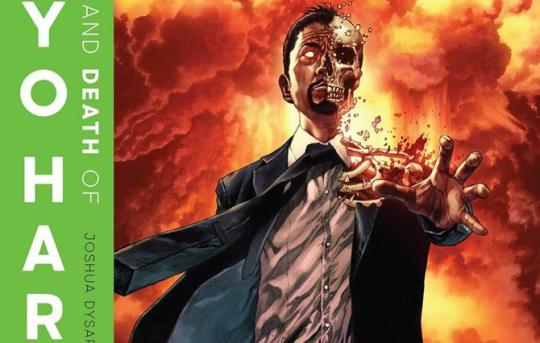
19. The Life and Death of Toyo Harada
Joshua Dysart, CAFU, Andrew Dalhousie & others
I think my favorite villain in all of comics is Toyo Harada? I know that’s a weird statement to make in a universe with a Jonathan Hickman-written Magneto in stores and a Jonathan Hickman-written Doom on my shelf, but there’s a big difference between good big-2 bads and Harada: Harada’s right.
read more: The Best TV Episodes of 2019
Harada’s goal is to push humanity to a utopia. He’s extremely down on the current construct of global governance, so his methods are decidedly authoritarian, but his diagnosis of the problem and his end goal are both 100% correct, and that makes him a fascinating villain. And this book, created by the people who helmed most of the flagship books of the first wave of Valiant comics since it returned in 2013, feels like a way to close off that chapter by putting Harada back in a box for a little while. Every issue of this series has CAFU doing present-day art and an all-star guest (Doug Braithwaite, Adam Pollina) drawing flashbacks to earlier periods in Harada’s life. It looks fantastic. And it reads great: Harada is every bit the manipulative bastard he’s been since the first Harbinger book rolled out years ago.
read The Life and Death of Toyo Harada on Amazon

18. Coda
Simon Spurrier, Matias Bergara, Michael Doig
God, what a gorgeous comic Coda is. Matias Bergara is well on his way to stardom because of it, and it’s well deserved.
Coda is a story about a marriage falling apart, set against a high fantasy backdrop where a catastrophe stripped the world of almost all of its magic. Over the course of its 12 issues, it morphs from a fairly stock fantasy comic with flashes of brilliance in its relationships, into a story about stories that manages not to climb up its own ass and perch on some intestinal pretense. The last quarter of the story is elegant, sweet and earnest, and more than makes up for some dragging in its middle.
read more: The Best Movies of 2019
What keeps the story moving through that middle, and what lands it so beautifully, is Bergara’s stunning art. It’s more mad and inventive than what the story implies, but bright and clear all the same. It’s almost like early period Chris Bachalo but with modern production values. When I first thought this, my inner monologue said it in a hushed whisper, like it was blasphemy. But the further into the book I went, the more confident I was in the assessment. Coda is a moving story that’s also one of the best looking comics of the year.
read Coda on Amazon
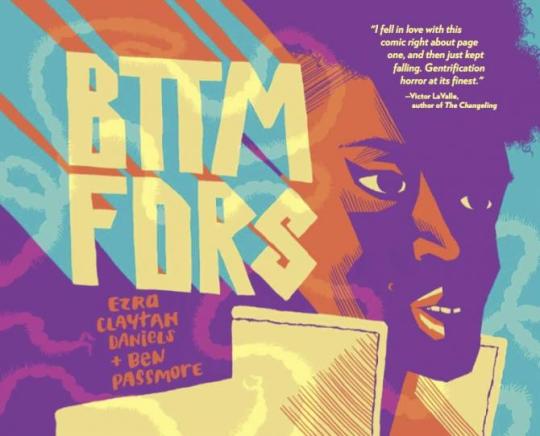
17. BTTM FDRS
Ezra Claytan Daniels (W), Ben Passmore (A) Fantagraphics
True story: I was about a third of the way through BTTM FDRS and I sat down with a goal of reading 15 or so more pages. I stood up 40 minutes later having ripped through the last 200 pages of the comic, and regretted it from about five different angles. You'll hit a point where you won't be able to put it down. It’s a terrific horror story.
BTTM FDRS is transparently a story about how awful gentrification is. Two hipsters move into an old industrial building in a not-quite-yet up and coming neighborhood, and they’re pretty shitty. They meet a neighbor, a theme rapper who dresses in colonial gear and calls himself Plymouth Rock. And then they all get trapped in their new haunted house, one that’s full of environmental and body horror.
On its surface, BTTM FDRS is extremely not subtle. One of the gentrifiers is wearing one of those hideous 80s cyclist hats that says “RAP” on the bottom of the upturned brim. But at the same time, the horror components of the book are much more subtle about the overall theme. I don’t want to spoil it too much, but the monster ties into the gentrification idea very nicely. Passmore does a great oozing monster and outstanding terrified cartoon faces, and the end result is a smart, thoughtful, great looking comic.
read BTTM FDRS on Amazon
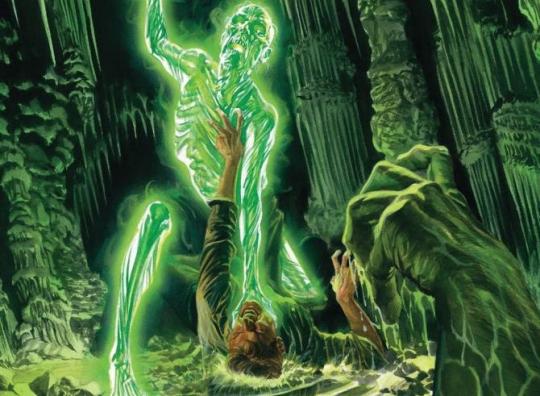
16. The Immortal Hulk
Al Ewing (W), Joe Bennett (P), Ruy Jose (I), Paul Mounts (C) Marvel Comics
The Immortal Hulk is easily the best horror book to come out this year. At least the best deliberate horror book, that’s not about gross medical malpractice or the hellscape our world has become. It’s incredibly fun to watch comic creators jump from good but underappreciated to superstars, and to see two creators do it on the same book is even better. That’s what’s happening here: Ewing and Bennett are going from “oh man, how great was Ultimates 2/52” to “holy shit I need to buy everything they do."
There’s a lot to love about Immortal Hulk - the way Ewing juggles so many characters, or how deliberately paced the story and the additions of new gamma characters is. But the best part is how utterly perfect the body horror is. The Rick Jones Abomination monster is the most disgusting thing I’ve seen in comics all year. A grasping hand for a face is somehow grosser than those fish with the human teeth that make a mass extinction an okay tradeoff. The way Hulk’s powers are played as grotesque metamorphoses is the best I’ve ever seen it done, and the slow burn mystery of the gamma world is what makes me rush back to this book every new issue.
read The Immortal Hulk on Amazon
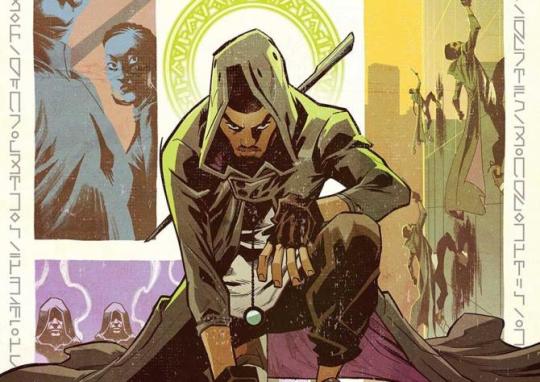
15. Excellence
Brandon Thomas (W), Khary Randolph (A), Emilio Lopez (C) Image Comics
Khary Randolph makes some of the most dynamic, visually entertaining comic art in the business, so you can probably guess how fast I jumped at him doing design work and interiors for a magic story. And it was the right call: Excellence is...well...excellent.
Spencer Dales is the son of a prominent ruling magical family who gets his magic late, and as a result watches his father bond with another kid as he teaches his new mentee how to wield mystical power. If you’re rushing past it, Excellence vaguely resembles Harry Potter, but it's full of resentment and totally different family drama, and the visuals are much flashier. It’s always near the top of my stack to read when it comes out.
read Excellence on Amazon

14. DCeased
Tom Taylor (W), Trevor Hairsine, James Harren & Stefano Gaudiano (A), Rain Beredo (C) DC Comics
I can’t believe this worked. I should have seen it coming - Tom Taylor, DCeased’s writer, was behind a lot of great comics in the last few years, including several (I’m looking at you, Injustice) that just shouldn’t have worked, but did. And yet, I saw “DC Zombies” and I rolled my eyes hard.
I shouldn’t have. DCeased is a gorgeous comic that made me cry at least twice. It does a better job of capturing the essences of pretty much the whole Justice League one by one than most of their solo books do: Batman, Superman, Flash, Black Canary, and Green Arrow all get amazing moments. To do this inside a zombie story is extremely difficult, but Taylor’s script is emotional and incisive, while Hairsine and Gaudiano work magic with the character acting and the horror of the book. It was so good that there’s still a part of me that can’t believe how much I want a sequel.
read DCeased on Amazon

13. They Called Us Enemy
George Takei, Justin Eisinger, Steven Scott (W); Harmony Becker (A) Top Shelf Productions
I’ll be honest, I came into this book not wanting to like it. It’s a non-comics celebrity airdropping into our medium - it felt a little bit like a stunt. But almost as soon as I cracked it open, I was struck by how much emotion Harmony Becker put into her art. George and his siblings are immediately charming and innocent, so when that innocence is stripped away from them by the way my country’s horrific internment of Japanese-Americans hits her, it hit me too, like a wave of shame.
Internment during World War II is one of the most shameful episodes in American history, and even an autobiography that tells that story must walk an incredibly delicate path - too far in one direction, and you’re sugarcoating terror; too far in the other and you drown the reader in sorrow and miss some of the human moments that make the story real. They Called Us Enemy walks that tightrope beautifully: throughout the book, you feel what George and his siblings felt. It’s a good story well told that is shamefully relevant to our world today.
read They Called Us Enemy on Amazon

12. Second Coming
Mark Russell (W), Richard Pace & Leonard Kirk (A), Andy Troy (C) Ahoy Comics
Second Coming is the other Russell book to make the list because this feels like where his comics career has been going the whole time. It’s got the brutal ridicule of modern society that made The Flintstones so amazing, and the incredibly thoughtful take on Christianity that was just beneath the thin veneer of comedy in God Is Disappointed In You. And shockingly, it might also be the nicest comic on the stands.
The hook of the story is exactly what it says on the tin: Jesus is back. Only this time God sent him to live with his brother, obvious-Superman-analogue Sunstar, because he got bullied so hard last time. So Russell, Pace and Kirk are putting a very biblically traditional Christ into a superhero crimefighter story and using both angles to mock (or gently rib, mostly) the other. It is a book that’s obsessed with pointing out how much better it is to treat people with kindness, and it’s really funny about it. Pace handles the God pages, and does everything with a scratchy, inky sketchiness that I love; he does layouts for the Sunstar pages, and Kirk and Troy finish them, and it’s pretty amazing how effortlessly the art goes back and forth between that scratchy 80s indie look and traditional, very good superhero art. Second Coming is a lot of fun to read.
read Second Coming on Amazon

11. Swimming in Darkness
Lucas Harari (W/A) Arsenal Pulp Press
Swimming in Darkness mixes a psychological thriller with a haunted house story, and the result is a haunting, creepy, gorgeous comic that sticks around in your brain far longer than you’ll be comfortable with.
Harari’s story takes main character Pierre, a French student who left school after a nervous breakdown, to the Vals Thermal Baths in the Swiss Alps. The Baths have a legendary architecture, and a myth around them that every hundred years they eat a foreigner. The book is the story of what he discovers while there.
The book is a lot of sitting quietly in weird architecture - it’s all mood and tension, and Harari does a great job with both. The Baths look wonderful, angular and bizarre, and the deliberate pacing goes a long way to making this book so effective.
read Swimming in Darkness on Amazon
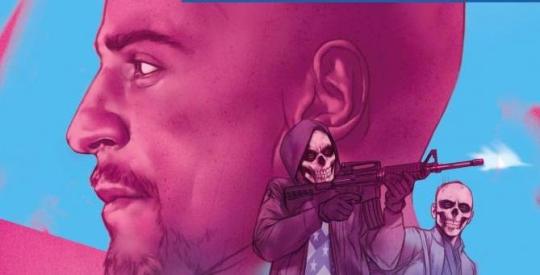
10. American Carnage
Bryan Edward Hill (W), Leandro Fernandez (A) Vertigo
American Carnage will go down as the last great Vertigo book. It’s just brutal from start to finish.
Hill and Fernandez send Richard Wright, a mixed race ex-FBI agent who can pass as white who was booted from the Bureau for killing a teenager who pulled a cell phone on him, deep undercover to infiltrate the white nationalist army being formed by a California billionaire and his daughter.
This is pure mid-period Vertigo out of the Scalped/100 Bullets mold. Everyone in this comic is an awful person, but they’re all terrible for their own reasons. And of course, there’s nothing even close to a happy ending. Fernandez’s art is a terrific match to the story. He’s loose and sketchy but always tells a clear story. American Carnage was an excellent comic. I hope we get Hill and Fernandez working together again soon.
read American Carnage on Amazon

9. Runaways
Rainbow Rowell (W), Kris Anka (A), Matthew Wilson (C) Marvel Comics
I liked Runaways a lot when it was originally created, but I wouldn’t call myself a dedicated fan. But I binged Rowell, Anka and Wilson’s newest volume, and I was shocked: at how easy they made it to step right into basically an in-progress retcon; at how masterfully Rowell juggles a HUGE cast of characters; and at how much damn fun the book is.
This book is pure teen soap opera. The point of the book is unambiguously the emotions of the characters and not high action and adventure, and Rowell makes each character’s distinct voice so entertaining to track through the melodrama that it’s now one of the first things I read when a new issue hits. Anka does faces and acting deceptively well for such a fashionable artist, and Wilson is, as usual, amazing. Runaways is a great book; you should definitely think about giving the first volume to comic reading friends as a holiday gift.
read Runaways on Amazon
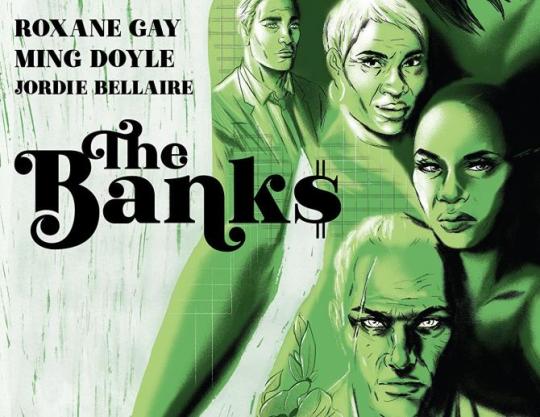
8. The Banks
Roxanne Gay, Ming Doyle, Jordie Bellaire TKO Studios
The best heist stories are a little bit angry, and Roxanne Gay, Ming Doyle and Jordie Bellaire's The Banks gets a family crew together for some purposeful theft that's amazing fun to read. The book sets three generations of women on a path to a big score that takes down some garbage people, including the man who killed the youngest Banks' grandfather.
The heist is fun and tense, but it's Doyle and Bellaire's artwork, and the relationships between the three generations of Banks women that make this comic so good. Doyle tells a hell of a story: the art is crisp and clean and clear, with wonderful subtelty to the body language and really sharp character designs. Bellaire's colors make the book drip with atmosphere. And Gay and the rest of the team do an outstanding job of building conflict into the leads. You ache with them at the murder of Clara's husband, and you feel the anger when Clara and Celia butt heads. That makes the payoff to the story even better: the deeper into the family dynamic you are, the higher the tension is, and Gay, Doyle and Bellaire do a great job of pulling you in.
read The Banks on Amazon

7. Superman’s Pal, Jimmy Olsen
Matt Fraction (W), Steve Lieber (A), Nathan Fairbairn (C) DC Comics
I’ve already talked at length about what makes Superman’s Pal, Jimmy Olsen so incredible, but I want to bring up one thing I’ve missed: its fundamental compassion. This book is every bit as hilarious and even a little daring for a mainstream superhero book (not often you get a joke at the expense of the internet’s collective foot fetish in a Superman comic), but underneath that, Jimmy Olsen is an incredibly empathetic, compassionate book. Packed in between panels of invisible Jimmy running from monsters and growing tusks at a pie-eating contest, there’s one quick panel of an exhausted, broken Jimmy in full fatigues and bullet proof vest, and Clark looking over his shoulder, worried.
Photography in a war zone is an incredibly dangerous job that kills a lot of real world journalists. To slip that in with Clark as the audience stand in completely changes the nature of the book - Jimmy’s every bit as tough as Lois and Clark are, dedicated to showing people the horrors of war to the point where he puts his own life in grave danger, and the fact that one time he took a shower in pink Kryptonite doesnt’ change that at all. Superman’s Pal, Jimmy Olsen is an amazing, hilarious comic, but it also deeply cares for the Superman universe’s mythos and is adding some great stuff to it.
read Superman's Pal Jimmy Olsen on Amazon
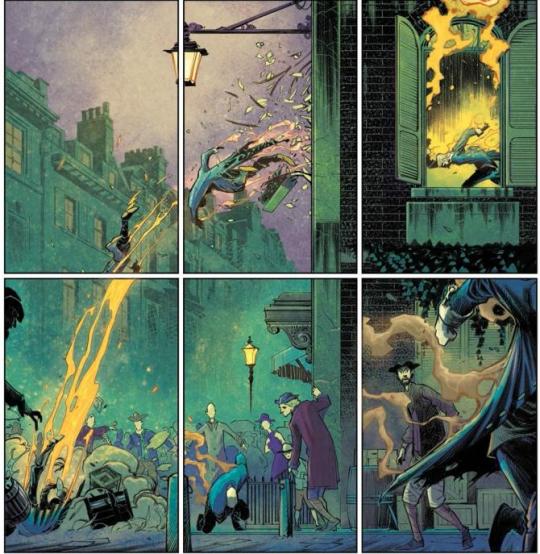
6. These Savage Shores
Ram V (W), Sumit Kumar (A), Vittorio Astone (C) Vault Comics
I’m constantly looking for something I’ve never seen before. Ram V, Sumit Kumar and Vittorio Astone gave me that with These Savage Shores, and they did it with some really impressive technical skill.
These Savage Shores is a period piece about a vampire/demon battle that plays out between London and Calcutta via the East India Company. It manages to be a monster story, a period drama, a monster book and a history lesson all at the same time. Ram V balances each piece of the story delicately and makes it really tough to put down.
Kumar’s art is a huge draw. This is the first work I’ve seen from him, but holy socks it’s terrific. The figures and backgrounds have a very Bilquis Evely/The Dreaming feel to them, but the layouts are spectacular. The way he uses the nine panel grid is simultaneously deliberate and dynamic. Astone’s colors are a perfect pair - London is gray and drab and rainy, while the jungle outside Calcutta is close and sticky and warm. It’s phenomenal work.
read These Savage Shores on Amazon
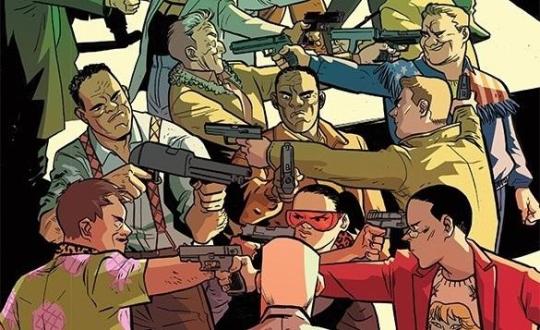
5. Assassin Nation
Kyle Starks (W), Erica Henderson (A) Image Comics
Kyle Starks is great. He’s absolutely hilarious, and fills his writing with a surprising amount of heart and an overwhelming amount of imagination. But if we’re being completely honest, the guy who wrote Sexcastle is maaaaybe not the most subtle comic talent out there. But to be honest, I didn’t realize that subtlety would improve his work until I saw Erica Henderson do it for him, and the resulting comic, Assassin Nation, is brilliant and one of my favorites from either creator.
The book is about the world’s greatest assassins - all ranked according to skill and kill counts - and a set up that’s causing them to be picked off in large numbers. It’s jammed with jokes of every kind - sight gags, satire, inane absurdism (Fuck Tarkington is the breakout character of 2019). Henderson is an absolute wizard. She’s such a good storyteller that I’ll read anything she does, with any writer and any characters. I knew Assasin Nation would be good when I heard about it, but I had no idea how great it would turn out.
read Assassin Nation on Amazon
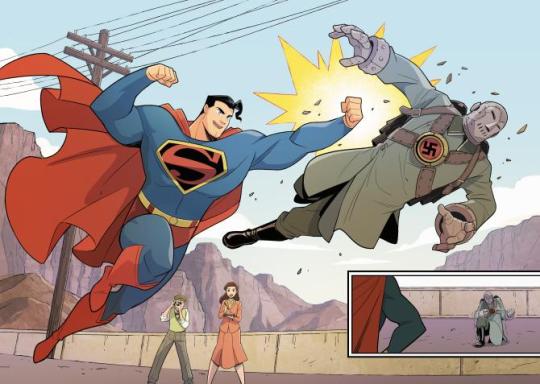
4. Superman Smashes the Klan
Gene Luen Yang (W), Gurihiru (A) DC Comics
Gene Yang is one of the best writers working in comics. He’s thoughtful and diligent about his characters, which lets him get deep inside their heads and flesh them out fully, both through their actions and how he poses them in the story. And he took an old Superman tale - Superman Smashes the Klan is based on a story from the old radio show - and made a couple of tweaks to it to turn it into one of my favorite character studies of Superman and Clark Kent that I’ve ever read.
By putting Roberta and Mrs. Lee in the story, we get an entirely different point of entry to the tale, and two new point of view characters to look at Superman through the immigrant experience. I still don’t want to spoil anything, more because I won’t be able to relay the elegant simplicity of the statement the same way the text does, but it recast, for me, Clark Kent’s existence specifically in a way that makes my whole relationship with Superman as a character richer.
Gurihiru is the perfect art team to pair with Yang on this. They make Superman accessible and welcoming, but intimidating and obviously super at the same time. This is a great Superman story told well, and exactly what I want out of the character.
read Superman Smashes the Klan on Amazon

3. House of X/Powers of X
Jonathan Hickman (W), Pepe Larraz/R.B. Silva (A), Marte Gracia (C) Marvel Comics
There’s probably not much more that I can say about HoXPoX that I haven’t already said. The “two series that are one!” were everything I hoped they would be going in: intricately plotted, skillfully told and wholly different from what came before. I wasn’t expecting career-making work out of Larraz, Silva and Gracia, but their art was so good that people will be holding this run up to everything they do in the future as an incredibly high bar for them to hit again. These 12 issues were the best X-Men comics I’ve ever read as they came out.
I do think the entire experience of HoXPoX changed my expectations from comics. Hickman talked a lot in interviews about giving readers the most bang for their buck, and the care put into every detail on every page made that concern evident. I spent as much time pouring over every page of these comics as I do reading all the rest of my books combined every Wednesday. The data pages were an immersive, interesting way of dropping information on the reader - because they were presented as data collected by the characters, instead of pace-breaking infodumps, they brought you deeper into them. And the internet was legitimately a blast while these comics were coming out. I’ve never actually had fun on Twitter before, but the X-community made this reading experience even better, and a book that wasn’t up to these standards, even if it was still excellent, wouldn’t have inspired that.
read House of X/Powers of X on Amazon

2. Kid Gloves: Nine Months of Careful Chaos
Lucy Knisley (W/A) First Second
Kid Gloves, Lucy Knisley’s half women’s health explainer, half memoir about her pregnancy, was making the list about halfway through the book, when I realized I had ripped through that much of the story in only 20 minutes, and I was retaining just about everything. I knew it was going near the top of the list when I ended the book in tears, muttering “you sue that doctor until he’s dead” at it.
Knisley has a gift for conveying information, and the parts of the book that aren’t memoir are thoroughly researched, deeply informative and entertainingly presented. Parts of it read as a history of women’s health, and parts as an infographic about the current state of it, but all of it will make you mad and want to change things. But the memoir segments are brutally honest about how joyful and shitty and terrifying and mundane pregnancy can be, about how normal the scary parts are and how extraordinary the whole process can be. Kid Gloves was extra real to me because I’m still close enough to my family’s experience where it was like a read along, but her honesty and her cartooning skill make it easy to disappear into her story regardless of what you’re bringing to it as a reader. Kid Gloves was a delight to read.
read Kid Gloves: Nine Months of Careful Chaos on Amazon
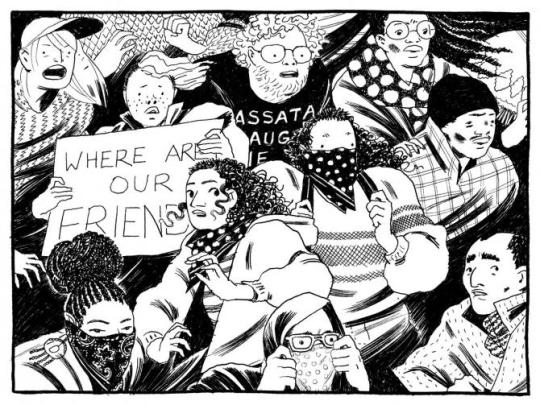
1. The Hard Tomorrow
Eleanor Davis (W/A) Drawn & Quarterly
Eleanor Davis is something else. What she does with pacing and perspective made me feel unlike any other comic I read this year. It’s truly exceptional comic art, and even if you don’t like the politics of the book, you should pick it up. I promise you won’t be able to put The Hard Tomorrow down.
The comic is about Hannah and John, two young lefties living out of a car trying to get pregnant and build their own house. Hannah is a home health aide and a member of a protest group, and John’s a stoner who grows weed and trades it to their handyman for his work. The book follows the two of them through their lives as the cops clamp down on the group, and John gets roped into their handyman Tyler’s Infowars-ish compound.
About two thirds of the way through the book, it starts barreling towards its climax - a bunch of leaders of Hannah’s protest group get arrested, the resulting protest turns into a riot, and the leaders eventually sell the group out to get their families and lives back. Meanwhile, John visits Tyler’s compound and gets subjected to Tyler’s increasingly deranged worries. Hannah gets a call from one of the freed group leaders and told that they’re being hung out to dry, and when that call ends, the panel pulls way back to show Hannah and the woman she’s caring for sitting alone, shocked, from a distance. Two pages later, Tyler tries to convince John to learn to shoot and hands him a gun, and we get a full page splash closeup of the handgun in John’s hand. This is incredible storytelling - Davis starts really building to the climax with this sequence, and it hit me like a violin crescendoing into a string snapping on a minor chord. She does the same thing with the end, slowing time down and using five splash pages almost like a flipbook animatic to hammer home her semi-resolution. The Hard Tomorrow is an incredible piece of comics storytelling, easily the best comic I read this year.
read The Hard Tomorrow on Amazon
Read and download the Den of Geek Lost in Space Special Edition Magazine right here!
facebook
twitter
tumblr
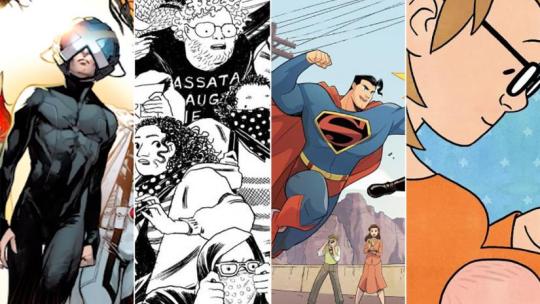
The Lists Jim Dandy
Dec 23, 2019
Mark Russell
DC Entertainment
Valiant Comics
Image Comics
Vertigo
Boom! Studios
IDW Comics
Marvel
from Books https://ift.tt/34Rjuw0
0 notes